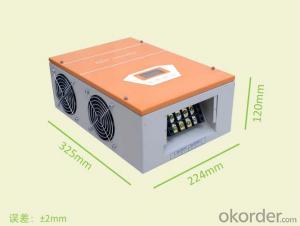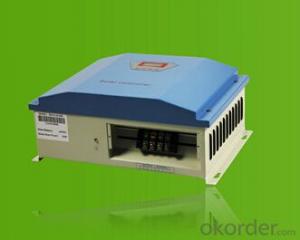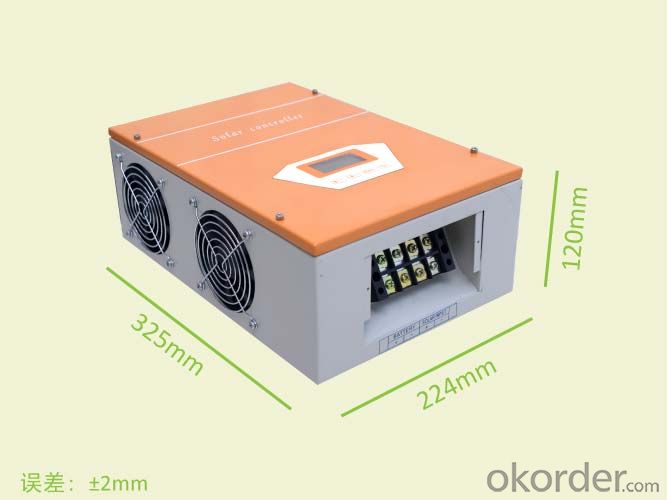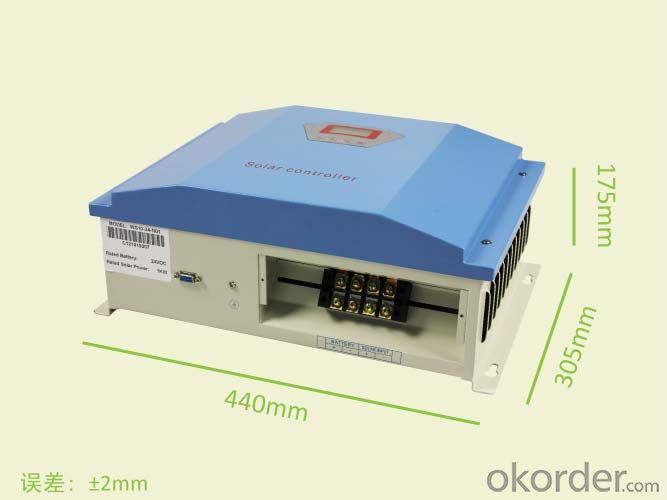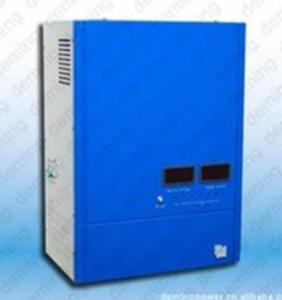1KW-MPPT Charging Function-Solar Charge Controller
- Loading Port:
- Shanghai
- Payment Terms:
- TT or LC
- Min Order Qty:
- 1 unit
- Supply Capability:
- 10000 unit/month
OKorder Service Pledge
OKorder Financial Service
You Might Also Like
I. PRODUCT INTRODUCTION
Solar controller is control device which can control solar panel and transform solar energy into electricity then store to the battery bank. Solar controller is the most important part in off-grid system, whose performance has much effect on life expectancy and operation of the whole system, especially the battery expectancy. Or battery service life will be shortened by over charge or over discharge.
II. PERFORMANCE FEATURES
Superior military-grade components to ensure the product stability.
Perfect protection function, thus the system has higher reliability.
Check and set all operation parameters as requirement from LCD display.
PWM stepless unload mode, which burn the excess power into Dump load, making the battery charging in best status.
III. APPLICATION AREAS
Standalone Photovoltaic power station
Standalone Domestic household photovoltaic power system
Mobil communication base stations, expressway and other non-residential regions.
Coastal islands, remote mountainous, border posts for regions shortage of or without electricity.
Government demonstration projects, landscape lighting project etc.
IV. 1KW TECHNICAL PARAMETERS
Product Model | WS10-24-N00 | WWS10-48-N00 |
Rated battery power | 24V | 48V |
Rated solar input power | 1 kW | 1 kW |
Floating charge voltage | 29V | 58V |
Max Open Circuit Voltage | 50V | 100V |
Dimensions (L x W x H) | ||
Net Weight | 7kg | |
Display mode | LCD | |
Cooling | Fan | |
Protection Level | IP20(Indoor) | |
Quiescent current | ≤20 mA | |
Battery over charge; battery anti-reverse-connection; solar reverse charge protection; solar anti-reverse-connection; lightning protection. | ||
Ambient temperature | -20~+55℃ | |
Ambient humidity | 0~93%, without condensing | |
Working altitude | ≤4000m | |
In order to serve our customers better, our company can adjust parameter configuration according to customer’s requirement. | ||
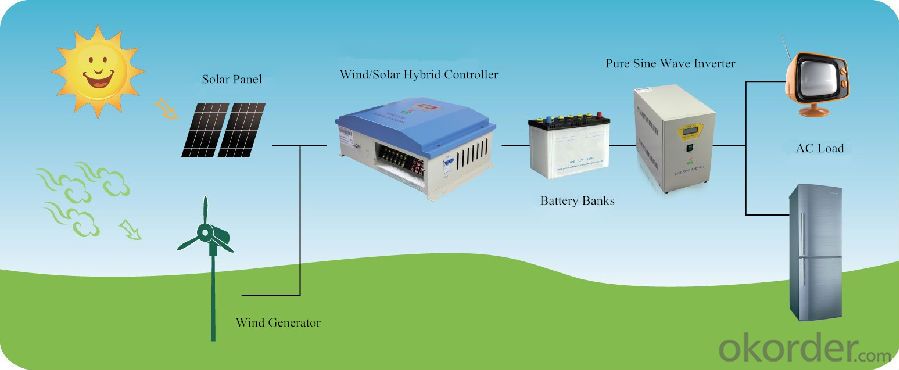
- Q: What is the role of a battery equalization function in a solar controller?
- The role of a battery equalization function in a solar controller is to ensure that all cells within a battery bank are charged and discharged evenly. It helps to balance the voltage and capacity of individual battery cells, thereby maximizing the overall performance and lifespan of the battery.
- Q: What is the maximum number of charging stages supported by a solar controller?
- The maximum number of charging stages supported by a solar controller can vary depending on the specific model and manufacturer. However, it is common for solar controllers to support up to three charging stages, which typically include bulk charging, absorption charging, and float charging.
- Q: What is the maximum cable size that can be used between the solar panels and the batteries?
- The maximum cable size that can be used between the solar panels and the batteries depends on the specific requirements of the solar system. Factors such as the distance between the panels and batteries, the amount of current being transferred, and the desired efficiency of the system will determine the appropriate cable size. It is recommended to consult with a professional or refer to the manufacturer's guidelines to determine the maximum cable size for a specific solar system.
- Q: Can a solar controller be used with solar-powered outdoor lighting?
- Solar-powered outdoor lighting can indeed use a solar controller. In fact, a solar controller is a crucial component of a solar power system, which includes solar-powered outdoor lighting. Its main function is to regulate and manage the energy flow from the solar panels to the lighting system, guaranteeing efficient charging and optimal performance. Moreover, the solar controller plays a vital role in safeguarding the batteries by preventing overcharging or discharging, thereby extending their lifespan. Additionally, it offers various control features, such as timers, dimming options, and remote control capabilities, enabling users to personalize the lighting settings based on their preferences. All in all, a solar controller is an indispensable element of a solar-powered outdoor lighting system, ensuring its dependability and effectiveness.
- Q: Are solar controllers weatherproof?
- Yes, solar controllers are typically designed to be weatherproof. They are built with durable materials and sealed to protect against various weather conditions such as rain, snow, and extreme temperatures. This ensures their functionality and longevity in outdoor environments.
- Q: Can a solar controller be used with a solar-powered office building?
- Yes, a solar controller can be used with a solar-powered office building. A solar controller is a device that regulates the charging and discharging of batteries in a solar power system. It helps manage the flow of electricity from the solar panels to the batteries and the building's electrical system. Therefore, it is an essential component in ensuring the efficient and effective utilization of solar energy in a solar-powered office building.
- Q: Can a solar controller be used with solar panel tracking systems?
- Yes, a solar controller can be used with solar panel tracking systems. The solar controller helps regulate the charging and discharging of the batteries connected to the solar panel tracking system. It ensures that the batteries are charged efficiently and protects them from overcharging or discharging. Therefore, a solar controller plays a crucial role in optimizing the performance of solar panel tracking systems.
- Q: Can a solar controller be used in a solar-powered data center?
- Yes, a solar controller can be used in a solar-powered data center. A solar controller regulates the charging and discharging of batteries in a solar power system. In a solar-powered data center, the solar controller plays a crucial role in managing the flow of energy from the solar panels to the batteries, ensuring optimal use of the available solar power.
- Q: Can a solar controller be used with solar panels of different ages?
- A solar controller is capable of being used with solar panels of various ages. Its role is to manage the energy transfer from the panels to either the battery or the grid. The controller's functionality remains unaffected by the age of the panels, as its main focus is on effectively handling the energy produced. Nevertheless, it is crucial to verify that the voltage and current ratings of the solar controller align with those of the panels being utilized. This verification ensures the system operates at its best and eliminates any potential harm.
- Q: How do I protect a solar controller from insects or pests?
- To protect a solar controller from insects or pests, you can consider a few measures. Firstly, ensure that the controller is installed in a secure and enclosed location, such as a locked box or an insect-proof housing. This will prevent insects or small pests from coming into direct contact with the controller. Additionally, you can use insect repellents or pest control methods in the vicinity of the controller to deter any potential pests. Regular cleaning and maintenance of the controller, including removing any debris or insect nests, can also help prevent insect or pest infestation.
Send your message to us
1KW-MPPT Charging Function-Solar Charge Controller
- Loading Port:
- Shanghai
- Payment Terms:
- TT or LC
- Min Order Qty:
- 1 unit
- Supply Capability:
- 10000 unit/month
OKorder Service Pledge
OKorder Financial Service
Similar products
Hot products
Hot Searches
Related keywords
